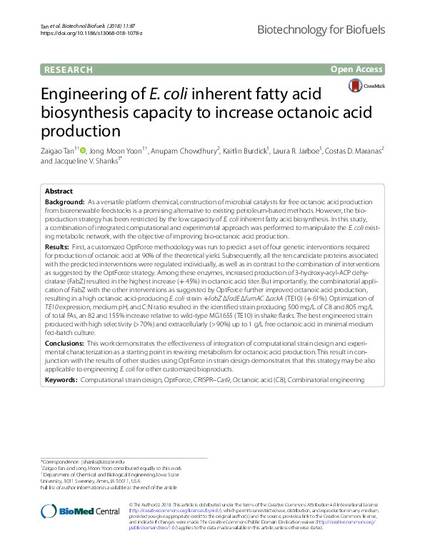
Background
As a versatile platform chemical, construction of microbial catalysts for free octanoic acid production from biorenewable feedstocks is a promising alternative to existing petroleum-based methods. However, the bio-production strategy has been restricted by the low capacity of E. coli inherent fatty acid biosynthesis. In this study, a combination of integrated computational and experimental approach was performed to manipulate the E. coli existing metabolic network, with the objective of improving bio-octanoic acid production.
Results
First, a customized OptForce methodology was run to predict a set of four genetic interventions required for production of octanoic acid at 90% of the theoretical yield. Subsequently, all the ten candidate proteins associated with the predicted interventions were regulated individually, as well as in contrast to the combination of interventions as suggested by the OptForce strategy. Among these enzymes, increased production of 3-hydroxy-acyl-ACP dehydratase (FabZ) resulted in the highest increase (+ 45%) in octanoic acid titer. But importantly, the combinatorial application of FabZ with the other interventions as suggested by OptForce further improved octanoic acid production, resulting in a high octanoic acid-producing E. coli strain +fabZ ΔfadE ΔfumAC ΔackA (TE10) (+ 61%). Optimization of TE10 expression, medium pH, and C:N ratio resulted in the identified strain producing 500 mg/L of C8 and 805 mg/L of total FAs, an 82 and 155% increase relative to wild-type MG1655 (TE10) in shake flasks. The best engineered strain produced with high selectivity (> 70%) and extracellularly (> 90%) up to 1 g/L free octanoic acid in minimal medium fed-batch culture. Conclusions
This work demonstrates the effectiveness of integration of computational strain design and experimental characterization as a starting point in rewiring metabolism for octanoic acid production. This result in conjunction with the results of other studies using OptForce in strain design demonstrates that this strategy may be also applicable to engineering E. coli for other customized bioproducts.
Available at: http://works.bepress.com/jshanks/11/

This article is published as Tan, Zaigao, Jong Moon Yoon, Anupam Chowdhury, Kaitlin Burdick, Laura R. Jarboe, Costas D. Maranas, and Jacqueline V. Shanks. "Engineering of E. coli inherent fatty acid biosynthesis capacity to increase octanoic acid production." Biotechnology for Biofuels 11, no. 1 (2018): 87. DOI: 10.1186/s13068-018-1078-z. Posted with permission.